
The gold miners’ stocks have certainly had a wild ride this year. After initially skyrocketing out of deep secular lows into a mighty new bull market, they recently suffered a massive correction climaxing in an extreme plummet. This coincided with gold stocks’ major seasonal low in October. That heralds their strongest seasonal rally of the year heading into and through winter, a very bullish omen for coming months.
Gold-stock performance is highly seasonal, which certainly sounds odd. The gold miners produce and sell their metal at relatively-constant rates year-round, so the temporal journey through calendar months should be irrelevant. Based on these miners’ revenues, there’s no reason investors should favor them more at certain times of the year than others. Yet history proves that’s exactly what happens in this sector.
Seasonality is the tendency for prices to exhibit recurring patterns at certain times during the calendar year. While seasonality doesn’t drive price action, it quantifies annually-repeating behavior driven by sentiment, technicals, and fundamentals. We humans are creatures of habit and herd, which naturally colors our trading decisions. The calendar year’s passage affects the timing and intensity of buying and selling.
Gold stocks exhibit strong seasonality because their price action mirrors that of their dominant primary driver, gold. Gold’s seasonality isn’t driven by supply fluctuations like grown commodities experience, as its mined supply remains pretty steady all year long. Instead gold’s major seasonality is demand-driven, with global investment demand varying dramatically depending on the time within the calendar year.
This gold seasonality is fueled by well-known income-cycle and cultural drivers of outsized gold demand from around the world. And the biggest seasonal surge of all is just now getting underway heading into winter. As the Indian-wedding-season gold-jewelry buying that fuels this metal’s big autumn rally winds down, the Western holiday season is ramping up. The holiday spirit puts everyone in the mood to spend money.
Men splurge on vast amounts of gold jewelry for Christmas gifts for their wives, girlfriends, daughters, and mothers. The holidays are also a big engagement season, with Christmas Eve and New Year’s Eve being two of the biggest proposal nights of the year. Between a quarter and a third of the entire annual sales of jewelry stores come in November and December! And jewelry historically dominates overall gold demand.
According to the World Gold Council, jewelry accounted for 58% of total global gold demand in 2014 and 57% in 2015. That works out to about 4/7ths of annual gold demand. The first half of 2016 proved a historic exception, as gold investment demand trumped jewelry demand for two consecutive quarters for the first time ever. Nevertheless jewelry demand still ran 40% even in H1’16’s young investment-driven gold bull.
This outsized Western jewelry buying heading into winter shifts to pure investment demand after year-end. That’s when Western investors figure out how much surplus income they earned during the prior year after bonuses and taxes. Some of this is plowed into gold in January, driving it higher. Finally the big winter gold rally climaxes in late February on major Chinese New Year gold buying flaring up over there.
So during its bull-market years, gold has always tended to enjoy major winter rallies driven by these sequential episodes of outsized demand. Naturally the gold stocks follow gold higher, amplifying its gains due to their great profits leverage to the gold price. Today gold stocks are once again just heading into their strongest seasonal rally of the year driven by this robust winter gold demand. That’s super-bullish.
Since it’s gold’s own demand-driven seasonality that fuels the gold stocks’ seasonality, that’s logically the best place to start to understand what’s likely coming. Price action is very different between bull and bear years, and gold is absolutely in a new bull market. Between the 6.1-year secular low it suffered in mid-December and early July, gold powered 29.9% higher easily exceeding that +20% new-bull threshold.
Gold’s last mighty bull market ran from April 2001 to August 2011, where it soared 638.2% higher! And while gold consolidated high in 2012, that was technically a bull year too since gold just slid 18.8% at worst from its bull-market peak. Gold didn’t enter formal bear-market territory at -20% until April 2013, thanks to the crazy stock-market levitation driven by extreme distortions from the Fed’s QE3 bond monetizations.
So the modern bull-year seasonality relevant to this new bull year of 2016 ran from 2001 to 2012, before the Fed-induced bear-market years between 2013 to 2015. This first chart distills down gold’s bull-year seasonal tendencies by averaging gold prices indexed within each calendar year. This methodology is essential because it renders price percentage moves perfectly comparable despite differing prevailing gold prices.
Gold’s close on the final day of each preceding year is recast at a level of 100, with all the following year’s daily gold closes indexed off that. An indexed level of 110 simply means gold is up 10% year-to-date at that point. Each calendar year’s individually-indexed gold prices are then averaged together to arrive at this gold-bull seasonality. Gold has always had a strong tendency to enjoy major winter rallies.
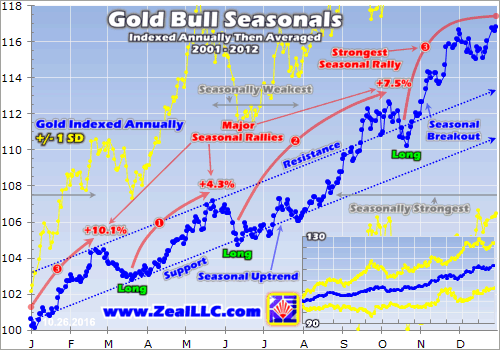
During its last bull-market years from 2001 to 2012, gold’s major winter rally started on average in late October. Technically gold’s major seasonal bottom averaged being carved on that month’s 16th trading day, which happened to be October 24th this year. From there gold surges into its strongest seasonal rally of the year. Between late October and late February in its last bull years, gold blasted 10.1% higher on average!
These big winter-rally seasonal gains are much larger than the 4.3% and 7.5% averages seen in gold’s other major seasonal rallies in spring and autumn! That makes late October one of the best times of the year to deploy capital into gold. That Western holiday gold-jewelry buying fuels such outsized demand that November has long proved gold’s best calendar month of the year with average bull-year gains of 4.0%.
While this bullish gold seasonality really moderates in December with an average 0.8% bull-year gain, it soon accelerates again in January on that surplus-income gold investment buying. The 2.7% average gain gold enjoyed in January during those bull years between 2001 to 2012 makes for this metal’s third best month of the calendar year. This winter-rally span is when gold enjoys its peak seasonal tailwinds.
Unfortunately the great majority of speculators and investors remain wary of deploying into gold to ride its strong seasonal winter rally. Just like last year, the former are terrified of the next Fed rate hike once again arriving in mid-December. Gold-futures speculators in particular have spent recent years fooling themselves into believing Fed rates hikes are gold’s mortal nemesis, despite history proving that totally false.
The record is crystal-clear, gold actually thrives during Fed-rate-hike cycles! Before today’s there have been 11 since 1971, and gold has averaged impressive 26.9% gains across the exact spans of all these Fed-rate-hike cycles. In the majority 6 of these where gold actually rallied, its average gains were a staggering 61.0%! In the other 5 where gold retreated, its average losses were an asymmetrically-light 13.9%.
Gold blasted higher during Fed-rate-hike cycles when they started with gold relatively low and unfolded at a gradual pace. Gold not only entered today’s current farce of a rate-hike cycle at major secular lows, the Fed under uber-dove Janet Yellen has never been slower in raising rates. With at least an entire year between hikes, it’s hard to imagine any more gradual. This snail-like rate-hike setup is very bullish for gold.
During its last rate-hike cycle between June 2004 to June 2006, the FOMC hiked at 17 consecutive meetings for a total of 425 basis points! That more than quintupled the federal-funds rate to 5.25%, an inconceivably-high level today. Even though that was an extremely-aggressive rate-hike cycle, gold still managed to power 49.6% higher over that exact span! Rate hikes are no threat to gold’s strong winter seasonals.
Meanwhile investors remain distracted by the Fed’s ludicrous stock-market levitation, which is retarding gold investment demand. When stock markets remain near record highs and drenched in complacency, investors aren’t interested in prudently diversifying into gold. Since gold tends to move counter to the stock markets, investment demand only surges when stocks weaken. That’s what ignited 2016’s gold bull.
As the Fed’s surreal stock-market levitation cracked early this year, American stock investors flocked to gold via shares in the flagship GLD SPDR Gold Shares gold ETF. When they buy its shares faster than gold itself is being bought, this ETF’s managers must issue sufficient new shares to offset all this excess demand and maintain gold tracking. The proceeds from these GLD-share sales are used to buy gold bullion.
Thus GLD holdings builds show stock-market capital migrating into gold. In Q1’16, GLD’s enormous 176.9-metric-ton build represented an incredible 80.6% of total worldwide demand growth in gold year-over-year. In Q2’16, GLD’s 130.8t build accounted for a colossal 93.6% of the total global increase in gold demand! The reason gold’s bull stalled in Q3’16 is because GLD’s holdings actually suffered a 2.1t draw.
When these lofty Fed-levitated stock markets inevitably roll over again, differential GLD-share buying will surge again for prudent portfolio diversification into gold. That will really add to gold’s strong winter seasonals, amplifying its rally in the coming months. And gold’s strongest seasonal rally doesn’t even need to be kick started by GLD demand resuming, as it relies on November’s strong holiday gold-jewelry demand.
So neither speculators’ Fed-rate-hike fears nor investors’ current apathy towards gold thanks to near-record stock markets are likely to short circuit gold’s strong winter rally this year. And if gold’s bull-market seasonals again prevail, that’s super-bullish for gold stocks in the coming months. They also enjoy strong winter seasonals thanks to gold’s, because gold miners’ profitability and thus stock prices leverage gold’s price action.
This next chart applies this same bull-market-seasonality methodology to the leading benchmark HUI NYSE Arca Gold BUGS Index. Naturally gold-stock seasonals closely mirror gold’s, so the miners are also just entering their strongest seasonal rally of the year. On average in those last bull-market years from 2001 to 2012, the HUI powered a whopping 15.9% higher between late October and late February!
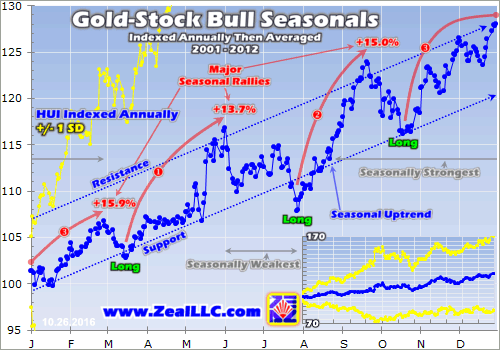
Gold stocks’ strong 15.9% average winter rally bests their 13.7% and 15.0% rallies heading into spring and autumn. On average gold stocks’ major seasonal bottoming heading into their winter rally arrives on October’s 15th trading day, which translates into October 21st this year. Like their primary driver gold, gold stocks tend to rally strongly in November, moderate in December, and then surge again in January and February.
And given the sentimental, technical, and fundamental setups for gold stocks entering this year’s winter rally, the usual seasonal tailwinds are likely to help propel them much farther than usual. Just like gold and because of it, gold stocks entered a mighty new bull market early this year as well. Between mid-January and early August, they skyrocketed 182.2% higher in just 6.5 months! It was a wildly-profitable run.
That left gold stocks overbought in the middle of summer, their weakest time of the year seasonally. So as I warned in early July, gold stocks’ record summer surge soon rolled over into a major correction. That quickly ballooned to massive proportions exceeding 20%, the threshold for new bear markets in general stocks. Then gold stocks started grinding higher again in September, but were slammed by gold futures in October.
Early this month the HUI plummeted 10.1% in a single trading day, one of its worst losses ever, after gold-stock stops were run. That was sparked by cascading forced stop-loss selling in gold futures as gold slipped below $1300. By the time the dust settled, the gold stocks’ total correction per the HUI had mushroomed to a staggering 30.9% in 2.2 months! Such an enormous selloff naturally spawned great bearishness.
So the gold stocks are now entering their seasonally-strongest period of the year universally despised and very low technically. These are screaming buy signals within ongoing bull markets, greatly upping the odds gold stocks’ next major upleg is just getting underway. Add the winter rally’s strong seasonal tailwinds to exceptionally-bullish sentiment and technicals, and gold stocks’ coming gains should prove exceptional.
The gold miners’ fundamentals also powerfully line up with the winter seasonal strength this year, really boosting the bullish outlook. These companies’ third-quarter operating results will be fully released by mid-November. And they are highly likely to reveal more big gains in operating profits despite gold’s recent weakness. Improving gold-mining fundamentals will entice in more investors, magnifying seasonal gains.
Gold averaged $1185 in Q1’16 and $1259 in Q2’16. That 6.3% quarter-on-quarter gain in average gold prices led to enormous surges in operating profitability of the elite gold miners. They are represented by the leading gold-stock ETFs, the GDX VanEck Vectors Gold Miners ETF for the majors and its sister GDXJ VanEck Vectors Junior Gold Miners ETF for the juniors. These ETFs’ component stocks are excellent.
Each quarter I analyze the operating performances of the individual gold stocks included in these top ETFs. Their cash flows generated from operations are a great proxy for current profitability. In Q2’16 on that 6.3% average-gold-price increase, the top 34 component companies of GDX saw their operating cash flows surge 32.3% higher quarter-on-quarter. And GDXJ’s skyrocketed an incredible 51.1% higher QoQ!
Q3’16’s average gold price climbed another 6.0% QoQ from Q2 to $1334, despite gold’s big recent pullback. So those elite gold miners of GDX and GDXJ are very likely to soon report another major surge in operating profitability! It wouldn’t surprise me to again see big gains approaching Q2’s, which would certainly spark great trader interest. Improving fundamentals aligning with seasonals portends big upside.
If the gold stocks were entering this winter-rally period drenched in greed after a powerful upleg, the seasonal tailwinds probably couldn’t overcome the healthy correction tendency. If the gold miners’ fundamentals were deteriorating, that would likely prove too much heavy lifting for seasonals. But with the strong winter-rally seasonals aligning with very bullish sentiment, technicals, and fundamentals, gold stocks should surge.
This last chart breaks down gold-stock seasonality into more-granular monthly forum. Each calendar month between 2001 to 2012 is individually indexed to 100 as of the previous month’s final close, and then all like calendar months’ indexes are averaged together. While this November-to-February winter-rally period doesn’t encompass most of gold stocks’ strongest months, it does enjoy the most-consistent gains.
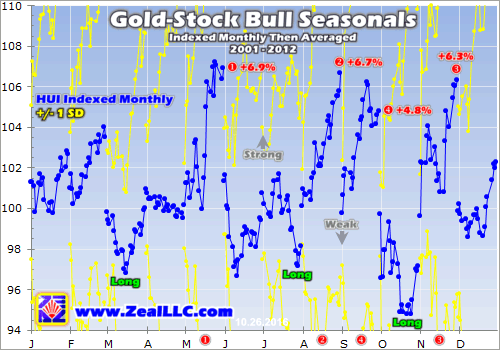
On average in bull-market years, November enjoys the third-best gold-stock gains of the calendar year at 6.3% in HUI terms. That’s not far off the best months of May and August, which have averaged rallies of 6.9% and 6.7%. But unlike the flat-or-lower months surrounding those other strong months, November is followed by December’s 2.3%, January’s 2.7%, and February’s 3.5% average bull-market-year gains.
This unparalleled consistency is what makes gold stocks’ winter-rally seasonals so impressively strong. Continuing to march higher on balance ultimately yields better upside than the two-steps-higher-one-step-back action throughout the rest of the calendar year. There are no significant gold-stock selloffs in seasonal-average terms at all between November and February, which facilitates exceptional winter gains.
Of course the standard seasonality caveat applies that these are mere tendencies, not primary drivers of gold or gold stocks. Seasonal tailwinds can be easily drowned out by bearish sentiment, technicals, and fundamentals. May and August this year are perfect cases in point. Instead of rallying 6.9% and 6.7% in line with seasonal averages in 2016, the HUI plunged 13.8% and 19.2% in May and August to shred seasonals!
Seasonality doesn’t always work, especially when it doesn’t align with the primary drivers of sentiment, technicals, or fundamentals in that order. Gold stocks entered both May and August this year up at very-overbought levels, at new bull-market highs stretched far above the HUI’s 200-day moving average. After rocketing 31.0% higher in April and surging up 11.2% in July, performance mean reversions were due.
Gold stocks’ resulting massive correction in August bucked the seasonal trends. While September saw a 4.3% HUI gain in line with normal +4.8% bull-market seasonality, early October’s plummet on stops being run was extremely excessive compared to normal October pullbacks. Thus gold stocks are unloved and oversold heading into this year’s winter-rally span, which is a super-bullish omen for outsized seasonal gains.
The serious gold-stock upside coming as bullish sentiment, technicals, and fundamentals align with seasonal tailwinds can certainly be played with those popular GDX and GDXJ ETFs. But because they hold so many gold stocks, their gains can only pace the HUI at best. A carefully hand-picked portfolio of elite individual stocks with superior fundamentals will really amplify sector gains, dwarfing the ETFs’ performances.
At Zeal we’ve spent literally tens of thousands of hours researching individual gold stocks and markets, so we can better decide what to trade and when. This has resulted in 851 stock trades recommended in real-time for our newsletter subscribers since 2001. Their average annualized realized gains including all losers are running way up at +24.1% as of the end of Q3! Why not put our expertise to work for you?
We’ve been super-aggressively adding gold-stock and silver-stock trades since that anomalous gold-stock plummet in early October. These new trades are already detailed in our popular weekly newsletter, and coming soon in our monthly one. Both draw on our vast experience, knowledge, wisdom, and ongoing research to explain what’s going on in the markets, why, and how to trade them with specific stocks. Subscribe today! For just $10 an issue, you can learn to think, trade, and thrive like a contrarian.
The bottom line is gold stocks are just entering their seasonally-strongest period of the year. Their big winter rally is fueled by gold’s own, which is driven first by outsized demand from holiday jewelry buying and later new-year investment buying. So both the metal and its miners’ stocks have strong tendencies to rally between late October and late February in bull-market years. It’s the best calendar span to own gold stocks.
And this year’s coming winter rally looks exceptionally bullish because the seasonal tailwinds won’t be overpowered by bearish sentiment, technicals, or fundamentals. All of these primary drivers are bullish today and closely aligned with the strong seasonals, making for a powerful united force to propel gold stocks dramatically higher. Speculators and investors alike should be fully deployed for the coming months.

1. The US election is now only about two weeks away. The winner of this election is likely to be… gold. Here’s why:
2.Both candidates are eager to increase infrastructure spending, and that’s likely going to open the door to congressional discussion of the issuance of perpetual bonds (aka “perps”).
3. That’s inflationary. It is also going to lead to a significant drop in central bank credibility, because central banks will be reluctant to increase the cost of borrowing for governments at a time when governments want to borrow more for their infrastructure spending schemes.
4. Please click here now. The longer that central banks wait to increase interest rates more consistently and substantially, the more dangerous the credit bubble becomes.
5. Also, bank loan profits have been in a twenty-year bear cycle. That has caused a vicious deflationary bear cycle in money velocity.
6. Central banks are prolonging that bear cycle by promoting unprecedented growth of government debt and unfunded social programs.
7. The longer that central banks wait before moving interest rates noticeably higher, the more violent the liquidity flows from the government bond markets will be when the rates are finally hiked.
8. In my professional opinion, I think most career politicians really believe the world is in a “new era”, where governments can take on unlimited amounts of debt without any real consequences.
9. Central bankers are supporting this fantasy world view by pretending that the economic upcycle now in play from 2009 was created by them.
10. They created nothing except more danger for pension funds and government bond investors. Central banks effectively engineered a massive flow of bank assets into the stock market, real estate, and government bonds.
11. They did it with the biggest attack on Main street citizens in the history of America. Main street workers and pensioners have really been under constant attack since 2009, via QE and low rates.
12. The one rate hike that Janet deployed in December of 2015 has been the only real central bank help for Main street in the past seven years.
13. That help is just a drop in a bucket. Much more needs to be done in 2017. Main street needs four rate hikes over the next twelve months. I’m predicting they get two, which is better than one or none.
14. Western governments need twenty rate hikes from the US central bank. That’s the only way to force them to clean up their disgusting debt-obsessed acts. Sadly, in 2017 I expect most American politicians will cry like babies over just two rate hikes.
15. Paul Volker had no problem raising rates to 14% to reign in inflation. Janet Yellen should have even less issue with hiking rates to reign in government lunatics who act more like dictators than politicians. Government size is the disease. Aggressive rate hikes are the cure!
16. Gold is very well supported at this point in time. Please click here now. Double-click to enlarge. After bursting upside from a small symmetrical triangle pattern, gold is coiling nicely in a drifting rectangle pattern. My next short term target is $1285.
17. Please click here now. Double-click to enlarge this daily bars silver chart. I look for key non-confirmation events between gold and silver, and there’s a great one in play right now.
18. On this pullback, gold is trading near the key February highs, and has even traded below them, while silver has held well above its February highs.
19. That tells me that inflation is becoming a potential issue, and silver’s relative strength during this pullback is a very positive indication that 2017 will see inflationary pressures strengthen more than they already have in 2016. Two rate hikes in 2017 plus one in December of this year should be enough to reverse the bank loan profits and money velocity bear cycles.
20. I’ve predicted a revival in the Chinese gold jewellery market will commence by early 2017, if not sooner. Please click here now. Top Goldman economists are also very excited about the Chinese gold market.
21. The bottom line is that gold is well supported by both the Western fear trade and the Eastern love trade.
22. Please click here now. Double-click to enlarge. The risk-on dollar is drifting sideways against the safe-haven yen, and is technically overbought. If it starts to decline, I expect gold to race straight to my $1285 short term target zone.
23. Please click here now. Double-click to enlarge. The US T-bond has swooned since the Brexit vote occurred, and that’s been a headwind for gold. In 2017, I expect the T-bond to swoon more, but against a background of falling real interest rates and rising nominal rates. That’s good news for gold.
24. Gold stocks, like silver, are doing a bit better than gold itself is, compared to the February highs. Please click here now. Double-click to enlarge this daily bars GDX chart. I suggested the $22 area needed to be bought, and the pullback from the $32 area did halt in my target zone. GDX is now trading in a tight range between $22 – $25. I suggested traders could book light profits at $25, and that’s worked out well. Now, I think GDX is getting ready for a rally to $27, and pullbacks to $22 – $23 should be bought again, and sold between $25 – $27 for healthy profits!
Stewart Thomson of Graceland Updates, Guest Contributor to MiningFeeds.com

1. The SPDR fund tonnage increased again yesterday, and now sits at 967 tons. This is obviously good news for all higher gold price enthusiasts.
2.Please click here now. Double-click to enlarge. Gold is attempting to stage a nice upside breakout from a small symmetrical triangle pattern..
3. In the short term, whether a rally happens or not probably depends on what happens with the bond market. Please click here now. Double-click to enlarge this short term T-bond chart.
4. Since the Brexit vote occurred, both gold and T-bonds have been drifting lower. Sometimes gold leads the bond market. Sometimes it’s the other way around, but it will be difficult for gold to stage a major rally now without a bond market rally.
5. In the big picture, inflationary pressures are rising significantly, and in 2017 a divergence in the gold-bonds relationship may start to manifest itself.
6. Please click here now. Double-click to enlarge this long term gold stocks versus gold chart.
7. Gold stocks have been in a long twenty-year bear cycle against gold bullion, and the cycle won’t be over until money velocity and bank loan profits end their own twenty-year bear cycles.
8. I’ve suggested that 2017 is the year that happens. When it does, gold stocks should enter a multi-decade bull cycle that I would argue is better termed a “bull era”.
9. Please click here now. CNBC commentator Rick Santelli recently flew into a rage when hearing the news that Janet Yellen may try to seek congressional approval to buy stocks.
10. The average working class person in the Western world can’t afford to live normally anymore, even when working multiple jobs. Janet’s latest solution, horrifically, is to try to pump up the stock market even more than her predecessor already did with his crazed QE programs, and leave Main Street to rot.
11. Some gold analysts may cheer for more useless QE and other silly central bank schemes, but these programs are highly deflationary for Main Street. From a demographics standpoint, the West is an ageing society, so by definition QE cannot fix anything.
12. Attention gold stock enthusiasts: Inflating Wall Street and deflating Main Street does not create a bull cycle in gold stocks. It prolongs the twenty-year bear cycle. The bottom line is that QE is the disease, and rate hikes are the cure. Rate hikes end the madness of forcing an ageing society to move savings out of banks and into speculative investments to “promote growth”.
13. QE destroys the standard of living of the Western world’s working and middle classes. It makes housing an investment rather than a place to live. It encourages crazed government bureaucrats to borrow even more money than they already have done. That money is then promptly wasted on ludicrous regime change and entitlement schemes.
14. I have to wonder if the next program to “help” most of the Western world’s citizens will be for central banks to buy food commodities. That would make food an investment and completely annihilate the financial state of most citizens. Would Janet Yellen call that, “good news for inflation”? I don’t know. I would call it an act of lunacy.
15. The only things that QE has inflated are houses and government bonds, and that is opening the door to an “endgame” type of scenario.
16. Janet Yellen is going to have to face the fact that rate hikes are desperately needed to save Main Street from the government monster that is enveloping almost everyone, including the central bank. She’s also going to have to face the fact that the rate hikes are going to be followed by more PBOC devaluation of the yuan. The latest yuan devaluation is already in play now, in advance of an anticipated US rate hike in December.
17. There’s not going to be any “making America great again”. The demographics of America are the demographics of a dying empire, regardless of who is sitting in the big White House chair.
18. At some point, Janet Yellen and the rest of the Western world are going to have to accept that the West is out, and Chindia is in, in terms of empire leadership “action”.
19. Rising rates fit well with an ageing society. It’s just common sense. Rising rates stop real estate speculation and lower rents. Also, many senior citizens can’t afford the higher property taxes that are now in play in this “healthy” real estate market.
20. Going forwards, it’s madness to believe that roughly 350 million Americans can compete against 2.5 billion hungry Chindians. In a nutshell, it’s time for the West to retire from the empire leadership game, and enjoy that retirement.
21. The government bond market Ponzi scheme must end, and the diabolical attack on America’s elderly savers must end. Cowards attack the elderly, and Janet Yellen should think very hard about that fact at her upcoming rate policy meeting in December. I think Janet will do the right thing, not just in December, but throughout 2017.
22. I’m predicting that she is ready to begin raising rates more consistently, which is what she should have been doing from the start of the 2015 calendar year.
23. Please click here now. Double-click to enlarge this key GDX chart. Like gold bullion, gold stocks appear to be “ripe for a rally”. Note the position of my 14,7,7 Stochastics series oscillator, at the bottom of the chart, but please click here now. If Janet Yellen doesn’t get away from promoting government borrowing and crushing savers, money velocity and bank loan profits are not going to recover, and gold stocks are going to go right back down to multi-decade lows against both gold and the dollar.
24. Janet pulled the plug on QE, as I predicted she would. Now it’s time for her to stop doing the bidding of a debt-soaked government. It’s not time to make America great. It’s time to make it normal, by raising rates in December, and consistently in 2017. If she does that, gold stocks, money velocity, and bank loan profits will all soar while an out of control government gets taken to the woodshed, where it belongs!

The gold miners’ stocks are suffering from universal and overwhelming bearishness today, with nearly everyone expecting further selling. That’s the natural reaction following this sector’s recent massive correction, which climaxed in one of its biggest daily plummets ever witnessed. But within bull markets, there’s no better time to buy aggressively than deep in a major selloff that’s riddled with great doubt and fear.
The core mission of speculation and investment is so simple even children can easily grasp it, buy low sell high. The great challenges arise not from understanding, but execution. Actually buying low then selling high in real markets is exceedingly unnatural and uncomfortable. It requires traders to overcome their own greed and fear to do the exact opposite of everything their own instincts are screaming to do.
The only times speculators and investors want to buy aggressively is when it feels great to do so. That only happens late in powerful rallies, when everyone can clearly see how strong a sector’s performance has been. Traders then commit one of trading’s cardinal sins, extrapolating recent performance out into the indefinite future. They assume a red-hot sector will keep on rising, and eagerly rush to buy high after a rally.
That’s exactly what happened in gold stocks this past summer. This battered sector finally skyrocketed higher in 2016 after hard years of neglect. By early August, the flagship HUI NYSE Arca Gold BUGS Index had blasted an incredible 182.2% higher in just 6.5 months! Who wouldn’t love a sector that had nearly tripled in just over a half-year? Epic performance like that dwarfs everything else in all the stock markets.
So excited traders greedily threw capital at the gold stocks, succumbing to herd groupthink to believe this sector was on the verge of soaring even though it already had. That wasn’t buying low, but buying high. I warned in early July as gold stocks were starting to peak that a major correction was inevitable after such a radical surge higher. While it tarried for a few more weeks, it eventually arrived with a vengeance.
Buying high into widespread greed after a powerful rally is very foolish, as markets always experience sharp reversals soon after popular emotional extremes. The only traders who rode gold stocks’ mighty new bull to multiply their wealth were the smart contrarians who bought in low early in 2016. That was when gold stocks were universally despised, languishing at fundamentally-absurd price levels relative to gold.
Traders only want to buy when it feels good, when they’re excited like everyone else, after a sector has already rallied dramatically. But buying high almost always ends in major losses and many tears. This whole game demands buying low, which means when it feels bad. Any sector including gold stocks is only relatively cheap after a major selloff when most traders have already fled due to exceeding popular bearishness.
This demands contrarianism, a tough discipline of actively suppressing and fighting your own emotions that can only come from hard years of experience. Instead of doing what you want to do in the markets, you have to do the exact opposite. You buy stocks when it feels very uncomfortable, after a major selloff everyone is convinced will keep spiraling lower. Buying stocks low is always riddled with internal conflict.
The forging of battle-hardened contrarians able to multiply wealth in the markets by actually buying low and selling high is a difficult and demanding road. I’ve been trudging along it for decades now, and it truly never gets easy. For the past 17 years I’ve been sharing my own extensive market research and real-world trades through our financial newsletters, helping others overcome their own greed and fear.
One of the greatest challenges of this business is the great majority of speculators and investors still get excited about or ignore a particular sector at exactly the wrong times. They didn’t want anything to do with gold stocks back in January near 13.5-year secular lows, totally ignoring my contrarian pleas then to buy aggressively. Instead they foolishly stuck their heads in the sand, missing an epic buying opportunity.
The same thing is happening again today to a lesser degree. Gold stocks are screaming buys right now after a massive correction within their powerful young bull market. Yet traders are so wrapped up in their own fear, so influenced by groupthink herd fear, that they are blind to this incredible opportunity. While they refuse to buy low now, they will foolishly again eagerly rush to buy high after gold stocks double from here.
I’ve found the best thing to combat internal and prevailing fear is perspective. The gold-stock technicals indeed look rotten over the past couple weeks and months, and that’s what traders are extrapolating forward which is breeding today’s excessive bearishness. But within broader context, the technical and fundamental situations in the gold miners’ stocks today are amazingly bullish. Now is the time to buy Buy BUY!
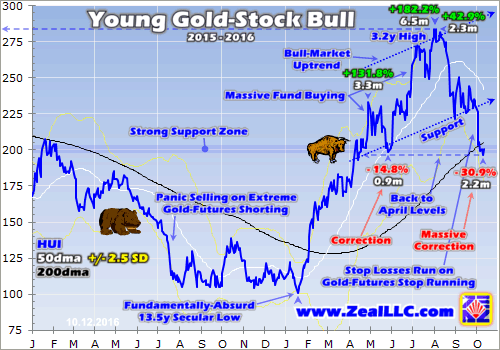
Last week this leading benchmark HUI gold-stock index plummeted 10.1% in a single trading day! That was the result of cascading selling driven by gold-stock stop-loss orders being triggered, which itself was driven by the same thing happening in gold futures. Last week I explained this running of the stops in gold and its miners’ stocks in depth if you need to get up to speed. It was a supremely-disheartening event.
This extreme selling anomaly that has decimated gold-stock sentiment truly erupted out of the blue with zero warning. The gold stocks had already corrected sharply in August, plunging 22.0% in just under a month per the HUI. Then they spent all of September grinding higher on balance along support of their strong bull-market uptrend. An entire month of higher lows confirmed technically their correction was over.
So last Tuesday’s brutal 10.1% plummet knifing through that late-August low like nothing was a big and ugly surprise. Such extreme down days in gold stocks are exceedingly rare, and therefore impossible to predict. Since 2001, the entire modern era, there have been 3976 trading days. And that was a volatile span for gold stocks, seeing them skyrocket 1664% higher at best in a mighty secular bull running 10.8 years!
Then after their September 2011 peak, the gold stocks spent the next 4.4 years plummeting a staggering 84.1% in a brutal bear. So volatility is no stranger to this sector. Yet since 2001, the HUI only suffered worse daily plunges than last Tuesday on 10 other trading days! That works out to a minuscule one-quarter-of-one-percent chance of a down day of that extreme magnitude. That’s wildly too seldom to be predictable.
On top of that, 7 of those top-10 HUI down days since 2001 came in the fourth quarter of 2008 during that first stock panic in a century. So excluding that exceedingly-anomalous epic maelstrom of fear, the HUI’s 11th-worst down day of the modern era last Tuesday is more like the 4th worst seen in non-panic normal market conditions. Something that radically abnormal and rare defies any attempt to model it.
When gold stocks plummet 10%+ in a single trading day, pretty much everyone prudently running stop-loss orders is going to be forced to sell. This spawns a gold-stock-downside feedback loop that quickly snowballs. The more gold stocks are driven to stop-loss levels leading to automatic selling, the farther they drop triggering still more stops. While very rare, cascading stop-loss selling is a downside juggernaut.
That extreme down day last Tuesday catapulted gold stocks’ total correction to 28.4%, while some minor follow-on selling pushed it to 30.9% over 2.2 months by this week! Naturally this has spawned universal fear and bearishness. In the general stock markets, a 20% drop is considered a new bear market. How can gold stocks hope to salvage their battered young bull if they’ve just lost nearly a third of their value?
The gold-stock sector is kind of like Texas, everything is outsized. Gold stocks enjoy massive uplegs that often grow radically larger than those seen in every other sector, and subsequently suffer proportionally massive corrections. All healthy bull markets see corrections arise periodically to rebalance sentiment, which keeps bulls healthy. The selling bleeds away the excessive greed seen at the preceding tops.
This paves the way for the next major upleg to start powering higher. Provocatively, massive corrections above 20% are par for the course in gold-stock bulls. Between 2001 and 2011, the average gold-stock correction in that epic secular bull was 26.1% excluding late-2008’s extreme stock-panic plunge. And a third of the dozen major corrections in that span even exceeded 30%, with the non-panic peak at a whopping 35.7%!
After gold stocks nearly tripled in just over a half-year, an extraordinary feat, correcting by a third isn’t out of line at all. The bigger the bull-market uplegs, the bigger the necessary corrections to keep popular greed in check. Greed naturally morphs into fear throughout corrections’ lifespans, and they ultimately bottom once nearly everyone has given up and written off the bull market for dead. That sound familiar?
Gold stocks are feared, hated, and despised today. You can hardly find any analysts or commentators who are not calling for and warning of more imminent selling. No one wants to touch this damaged sector with a ten-foot pole. Yet even at this week’s deep correction low following that anomalous plunge last week, the HUI was still up an astounding 76.5% year-to-date! Gold stocks still command 2016’s performance crown.
Despite all the wailing and gnashing of teeth these days, the gold miners’ young bull market remains very impressive technically. While the bull-market uptrend rendered above was shattered by the HUI’s precipitous stop-running plunge, it’s perfectly normal for bull uptrends to redraw themselves. They tend to steepen during uplegs before flattening in corrections, yet the bull itself keeps marching higher on balance.
The gold stocks bottomed right near their 200-day moving average, which is the strongest support zone seen in bull markets universally. Considering the gold stocks had stretched a whopping 74%, 70%, and 63% beyond the HUI’s 200dma in late April, early July, and early August, a 200dma approach is actually quite healthy for the ultimate longevity of this young gold-stock bull. Such convergences are strong buy signals.
In addition, all the gold stocks’ latest massive correction did was push them back to mid-April levels well into their new bull market. How many of the speculators and investors who were buying high during the summer upleg topping would have loved to have bought back in April instead? The gold stocks were poised to soon head another 47% higher then, and their upside from these same levels today is much larger.
Throughout bull markets, each subsequent upleg blasts gold stocks to new higher highs. There’s little doubt gold stocks’ next major upleg will catapult them to a new bull high way above their recent early-August peak. And bigger corrections make for more upside potential between their lows and the next uplegs their very selling births. Traders should be scrambling to buy gold stocks today after such a huge selloff.
While gold stocks’ miserable sentiment and exceedingly-bullish technicals are super-compelling, their fundamentals are even much more so. Gold stocks are ultimately just leveraged plays on gold, because gold-mining profits and thus ultimately stock prices greatly amplify gains in their primary driver. While gold’s own futures stop running pounded it last week, gold-mining operating profitability is still heading far higher.
Gold averaged $1185 in the first quarter of 2016 and $1259 in Q2. That 6.3% quarter-on-quarter gain in average gold prices led to enormous surges in operating profitability of the elite gold miners. They are represented by the leading gold-stock ETFs, the GDX VanEck Vectors Gold Miners ETF for the majors and its sister GDXJ VanEck Vectors Junior Gold Miners ETF for the juniors. Their component stocks are excellent.
Each quarter I analyze the operating performances of the individual gold stocks included in these top ETFs. Their cash flows generated from operations are a great proxy for their current profitability. In Q2’16 on that 6.3% average-gold-price increase, the top 34 component companies of GDX saw their operating cash flows surge 32.3% higher quarter-on-quarter. And GDXJ’s skyrocketed an incredible 51.1% QoQ!
The gold miners’ latest quarterly results for Q3 are gradually coming out over the next month or so. And last quarter the average gold price climbed another 6.0% QoQ from Q2 to $1334. So those elite gold miners of GDX and GDXJ are very likely to soon report another major surge in operating profitability. It wouldn’t surprise me to again see big gains approaching Q2’s, which would spark great trader interest.
The more gold-mining profitability grows, the more undervalued the gold miners look fundamentally. Given the dismal gold-stock sentiment out there today, I suspect most speculators and investors will be surprised by the gold miners’ strong Q3 results coming out soon. That’s a major buying catalyst just right around the corner, and an important fundamental reason to be aggressively buying gold stocks today.
Provocatively even at today’s gold-futures-stop-running-spawned low gold prices in the $1250s, gold stocks remain radically undervalued relative to this metal that drives their profits. This next chart looks at a proxy for that critical relationship in the form of the HUI/Gold Ratio. This simple construct shows when gold stocks are underperforming or outperforming gold, and how low or high they happen to be relative to it.
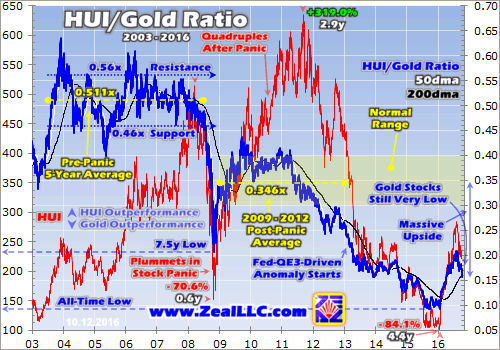
It was this very chart back in mid-January that convinced me to aggressively buy and recommend gold stocks when no one else wanted them. This hardcore contrarian buying into extreme bearishness led to realized gains for our subscribers running as high as 467% this year! While gold stocks are now well off their all-time lows relative to gold seen in mid-January, they remain way too cheap compared to the metal they mine.
Despite their immense gains this year, gold stocks have still only just begun the inevitable process of mean reverting out of their anomalous extreme undervaluations of late 2015 and early 2016. As of gold stocks’ latest massive-correction low this week, the HGR was merely running 0.157x. As revealed by this wildly-bullish chart, that’s still among the lowest levels ever witnessed. Gold stocks are still far too low!
The last normal years between 2008’s first stock panic in a century and the dawn of the Fed’s extreme market distortions in early 2013 were 2009 to 2012. During that post-panic span, the HGR averaged 0.346x. And that itself was pretty low, considering the pre-panic 5-year-average HGR of 0.511x. But for conservatism’s sake, let’s consider that post-panic-average 0.346x the mean-reversion upside target for gold stocks.
Even if gold does nothing and continues languishing in the $1250s, the gold stocks still need to surge another 121% higher from here merely to regain average pricing relative to gold! But this fundamental upside target is wildly too modest. Gold itself is due to head much higher as 2016’s heavy investment demand resumes. And market mean reversions out of extremes tend to overshoot proportionally, not just normalize.
Gold’s powerful young bull market fueling this year’s amazing gold-stock bull was overwhelmingly the result of American stock investors flooding into GLD gold-stock-ETF shares in response to the early-year cracking of the Fed’s stock-market levitation. As soon as today’s ridiculously-fake near-record US stock markets roll over again, investment demand for gold which moves counter to stocks will come roaring back.
Gold should easily regain 2012’s average levels of $1669 prior to the Fed’s extreme distortions from its unprecedented open-ended QE3 debt-monetization campaign. At that post-panic-average HGR level of 0.346x, that would yield a HUI upside target of 578 which is 194% higher from this week’s levels! I don’t know why any speculator or investor would forgo upside like that, no matter how scared they happen to be.
And if that HGR mean reversion overshoots proportionally to the opposite extreme above that average, it could briefly go as high as 0.599x. At 2012’s average gold levels of $1669, that implies a HUI target of 1000! While such an extreme would likely be short-lived in a greed-drenched peak, it leaves room for a quintuple from here. Traders should be buying today’s massive-correction gold-stock lows with reckless abandon.
The vast gold-stock upside coming as this young bull matures in the years ahead can certainly be played with those popular GDX and GDXJ ETFs. But since these ETFs hold so many gold stocks, their ultimate bull-market gains can merely pace the HUI at best. A carefully-handpicked portfolio of elite individual stocks with superior fundamentals will really amplify sector gains, dwarfing the ETFs’ performances.
The bottom line is gold stocks are a screaming buy today. Their powerful young bull already suffered a massive correction before being wracked by an exceedingly-anomalous stop-running-fueled plummet. That reignited and ballooned the healthy mid-bull selloff, naturally leading to extreme bearishness on this sector. But the gold miners’ technicals and underlying fundamentals still remain exceedingly bullish.
As gold’s own bull starts powering higher again as investment demand resumes when these lofty Fed-levitated stock markets inevitably roll over, the gold stocks are going to soar again. But as usual the only traders who will reap the coming massive gains are the prudent contrarians who can fight their own fear to buy low in this massive correction. Psychological discomfort is a small price to pay for multiplying your wealth.

1. The world is undergoing a major economic transition from deflation to inflation. Sadly, very few retail investors are correctly positioned to benefit from this exciting change.
2. In the big picture, the transition means that gold stocks will outperform gold bullion, and bonds will stagnate.
3. Chinese and Indian stock markets could boom. Western stock markets could also get dragged higher, but investors there have a lot more risk than Chindia investors.
4. To understand the fundamentals of the transition, please click here now. I predicted that Janet Yellen’s first actions as Fed chair would be to begin to transition a deflationary world to an inflationary one.
5. I said she would do that, ironically, by tapering QE to zero and raising interest rates, and that’s exactly what she is doing. Now, the world’s top institutional economists are beginning to adopt the same view that I had years ago, which is that QE is inflationary for Wall Street, and deflationary for Main Street.
6. Rising oil prices are already putting pressure on the yield curve and the ten-year bond. That’s likely to accelerate in 2017.
7. Please click here now. Top economists at JP Morgan, Merrill Lynch, and other major financial institutions are all turning negative on bonds, and becoming very positive about commodities.
8. These institutional money managers move truly gargantuan amounts of liquidity, and the early 2016 rally in gold stocks was the canary that sang loudly in the “inflation is coming” coal mine.
9. This transition is not going to benefit day traders. It’s going to benefit Western gold community investors with a long term horizon, and make them richer than they can possibly imagine.
10. It’s multi-year process, not an overnight event.
12. Please click here now. Western real estate can initially continue to do well as rates rise.
13. That’s mainly because Chinese markets are opening up wider, and citizens there are maniacal savers, sitting on about $25 trillion (USD) in savings. That money will continue to pour into Western real estate even as rates rise, because inflation will rise faster.
14. Please click here now. Top analysts at Barron’s believe peak liquidity and peak bond prices are here.
15. The bottom line is that with the exception of China, governments around the world have done nothing for Main Street while central banks have provided gargantuan stimulus to financial assets. That’s about to change, and the change is incredibly inflationary.
16. Please click here now. Double-click to enlarge. That’s a look at the Indian small caps market, which I cover in my https://gracelandjuniors.com
17. That market is up about 65% from the 2016 lows, and poised to blast out of a massive inverse head and shoulders bottom pattern. When inflation appears, small caps tend to outperform large caps in a major way.
18. India could potentially achieve 10% GDP growth very soon, and 8% seems like a “walk in the park”. As that growth continues relentlessly, commodities like oil (and especially uranium) are poised to benefit.
19. Please click here now. Double-click to enlarge. That’s the daily gold chart. I’ve outlined a bit of a grind for gold in the next few weeks.
20. From a fundamental perspective, gold needs another rate hike from Janet to move higher. In late 1979, rate hikes were negative for gold, but for most of the 1970s, gold went higher alongside rates, because inflation grew faster than interest rates.
21. In the current situation, interest rate hikes are incredibly positive for gold, because of the existence of the huge QE “money ball” that sits at the Fed and other central banks. Rate hikes incentivize banks to move that money out of the Fed and into the fractional reserve banking system.
22. Janet is unlikely to hike again until December, so gold is likely to grind sideways until then. If gold investors look closely at that gold chart, it’s clear that gold really has made little upside progress since it became clear in mid-February that Janet was going to delay further rate hikes.
23. To understand the potential for gold to grind sideways from a technical perspective, please click here now. Double-click to enlarge this monthly bars gold chart. Gold must grind sideways now, to form the right shoulders of a huge inverse head and shoulders bottom pattern.
24. I don’t expect the grind on the right shouldering process to take anywhere near as long to form as the left side did, which is good news for all gold price enthusiasts!
25. Please click here now. Double-click to enlarge this daily bars GDX chart. Gold stocks are also likely to grind sideways for now, and then begin an enormous rally in 2017. Gold stock investors should focus on the $22 and $18 price zones for fresh buying. What’s coming in 2017 is not a “bull market”. It’s the start of a wondrous bull era!
Stewart Thomson of Graceland Updates, Guest Contributor to MiningFeeds.com

Most companies in the mineral exploration industry have stated that their objective was year over year growth, only in recent years has this started to become a marginal struggle. As M. Dogget notes, notwithstanding more efficient production and focus on cost cutting, it is highly unlikely that most companies can grow in an industry where the overall value of production has remained essentially flat over a long period. According to SNL, the total estimated worldwide budget allocation for non-ferrous mineral exploration decreased by 18 percent in 2015 to about $8.8 billion.
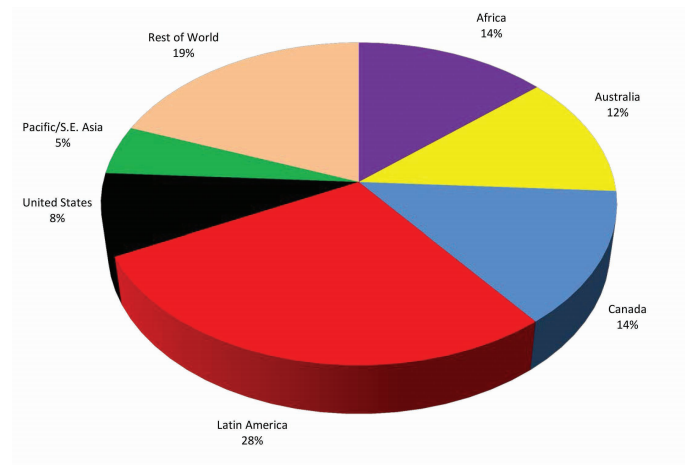
Throughout 2013 and 2014, markets were even less willing to support junior companies, and producers pulled back on capital and exploration spending in order to strengthen financial margins. The USGS 2015 Annual review revealed that the 2015 exploration budgets, in decreasing order, were reported for Latin America, Africa, Canada, Australia, the United States and the Pacific region. Exploration taking place in countries included in the “Rest of World” accounted for 19 percent of the global exploration budget, of which China and Russia accounted for about 57 percent of the regions’ budget total.
The exploration budget in 2015 in all regions was lower than the corresponding budget in 2014.
The largest decreases took place in:
- Africa (with a 30-percent decrease)
- Pacific region (28 percent decrease)
- Canada (20 percent decrease)
The smallest decreases took place in:
- United States (6 percent decrease)
- Latin America (13 percent decrease)
- Australia (15-percent decrease)
Latin America remained the region with the largest mineral exploration budget.
According to SNL’s World Explorations Trend 2016 Report despite five interest-rate cuts since late 2014, and additional measures designed to stabilise domestic markets or stimulate growth, China’s economic slowdown has continued, dragging many resource-based economies down with it. Given the uncertain demand, virtually all metals prices were in full retreat throughout 2015, ensuring that the downturn in exploration continued.
In 2015, companies lowered their budgets by another 18% to US$8.77 billion, marking the first time aggregate budgets had fallen below US$10 billion since the 2008-09 crash. Rarely immune to the traditional boom-and-bust mining cycle, junior companies continue to face considerable near-term uncertainty, with the past decade chronicling the rise and fall of the sector. Despite a modest increase in the funds raised through the first three-quarters of 2014, a dismal December quarter marked the beginning of an extended drought in exploration financings that has continued into 2016.
Lower commodity prices, in large part, owing to an economic slowdown in China and a relatively strong U.S. dollar, market instability and the reduction in available funding for mining projects in 2015 likely resulted in exploration budget cutbacks and reduced the number of junior and specialist companies like Castle Drilling Co. conducting minerals exploration.
Changing mineral commodity prices and commodity demand, relative currency exchange rates and increased exploration costs were among the considerations used by companies in determining exploration targets and development plans for 2015. Lower prices make it more difficult for smaller junior companies to obtain financing in a tight economy, so companies have been focusing available capital on fewer exploration projects.
During the past few years, declining metals prices, massive write-offs and languishing earnings made investors wary of the mining sector. Currency movements were an important consideration for the minerals exploration and mining sector in 2015. The U.S. dollar continued to strengthen against all other major currencies in 2015. A strong U.S. dollar makes U.S. mining-related exports more expensive for other countries and increases the costs associated with foreign projects that purchase goods or supplies using U.S. dollars.
Société Générale analyst, Robin Bhar, noted in mid-January that the negative developments in the financial markets were exacerbated by geopolitical tension. Bhar expects worries over China and the emerging markets to place severe pressure on base metals prices in the current quarter. Further price weakness, he said, should provoke a stronger supply response, eventually leading to a modest recovery. Bhar expects prices to recover gradually over the next two years, based on positive demand trends and reserves depletion that would eventually return the markets to deficit.
Given the existing project pipeline, base metals mine production (with the exception of bauxite) is likely to peak around 2018. Bhar predicts that “output would then decline at an accelerating pace unless higher prices stimulate investments and incentivize output from higher cost projects.” At the end of January, the World Bank published its latest Commodity Markets Outlook, in which it predicts a further 10% decline in metals prices this year due to “stubbornly elevated” metals supplies.
The World Bank’s projections follow an 8% fall in metals prices in the December quarter, which it blamed largely on slower growth in China’s economy and an overall increase in mined material. The Bank’s commodity price index fell 21% in 2015, ending the year 55% below the February 2011 high. The World Bank expects iron ore to suffer the most. Prices are slated to fall another 25% in 2016 and to sink further if China’s economy slows more than anticipated and/or production is higher than expected. Copper is also expected to fall on projected weaker Chinese construction and new supply coming online. For copper prices to improve in 2016, more significant mines may need to close, the World Bank said.
Why Has Gold Stalled?, a feature by A. Hamilton discusses Gold’s unusual performance high despite the current climate. Gold made a strong surge in Q1’16 gaining 16.1% making it Gold’s best quarter in 30 years, since Q3’86. Gold then struggled for the remainder of the year whilst slighted buoyed slightly by the kerfuffle of Brexit.
The up-down performance of minerals seems to be a trend that with confuse and infuriate investors as the industry strives to create more long-term meaningful growth.
Guest Author: Ben Howard

The end of the previous week was rich in signals as gold, silver and mining stocks all reversed along with the USD Index. Gold closed the week below the rising support line and the implications should not be ignored even by those who usually focus on fundamentals alone.
Why? Because in the short- and medium term, the important technical developments will shape the price – not the fundamentals. Why should one care? In early 2008 silver was priced above $20 and in late 2008 it was priced below $10, even though the fundamental outlook didn’t change. Similar price swings can make a lot of money for those who pay close attention to what’s going on – but knowing about positive fundamentals is not enough.
In the following part of the alert, we’ll show you what technical signs were available on Monday and Friday (this article is based on our Monday’s and Friday’s Gold & Silver Trading Alerts – we had opened short positions in metals and miners on Friday) that warned about the looming slide.
Let’s take a look at the charts (charts courtesy of http://stockcharts.com):
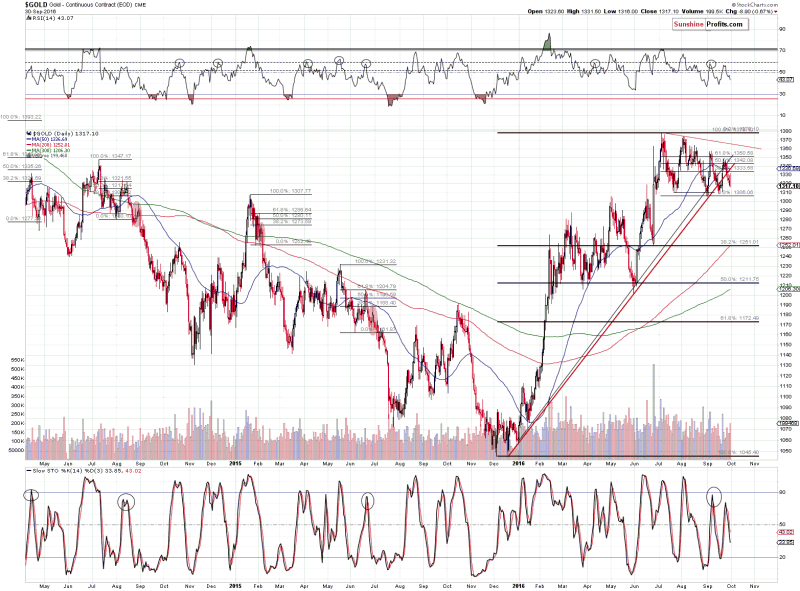
As indicated above, gold broke and closed the week below the rising support lines. This may not seem significant on a day-to-day basis (or when one focuses on fundamentals), but it changes a lot from the technical perspective. Technically, the 2016 rally is over. The weekly closing price is very significant and even without zooming in, the breakdown is clearly visible and the volume that accompanied the downswing was significant. The implications are very bearish.

Silver just formed a big reversal and the volume was significant. Actually, the volume alone is the factor suggesting that the top is in – please note what happened after sessions that were accompanied by huge volume in the past. Mid-April, early July, early September, mid-February – all these tops were accompanied by huge volume. The mid-April one was not the final top, but still, it was a good shorting opportunity – silver bottomed over $1 lower than that price after a huge-volume reversal.
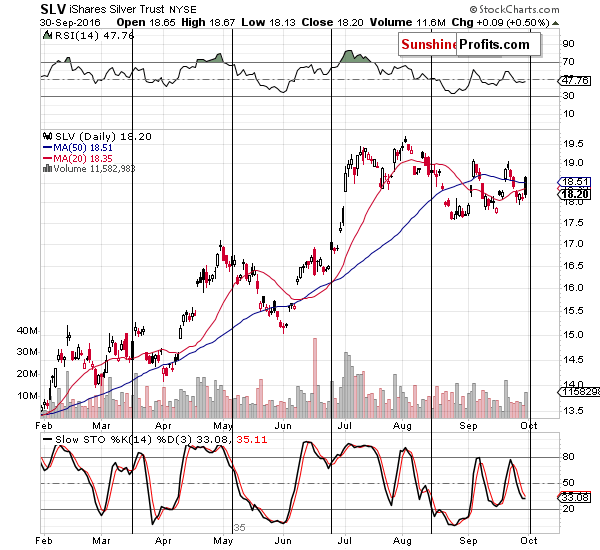
In terms of turning points, we get the same bearish implications. It “was about time” for silver to change its course and the thing was that we saw a decline instead of a short-term rally. That was a problem because, in general, the trend remains down, and the implications of the turning point after a decline would be bullish. It all changed based on silver’s intra-day rally. We now have silver after an intra-day rally and it seems that the next move will be to the downside.
Besides, the intra-day reversals in silver (which is particularly visible in case of the SLV ETF) also have very bearish implications.
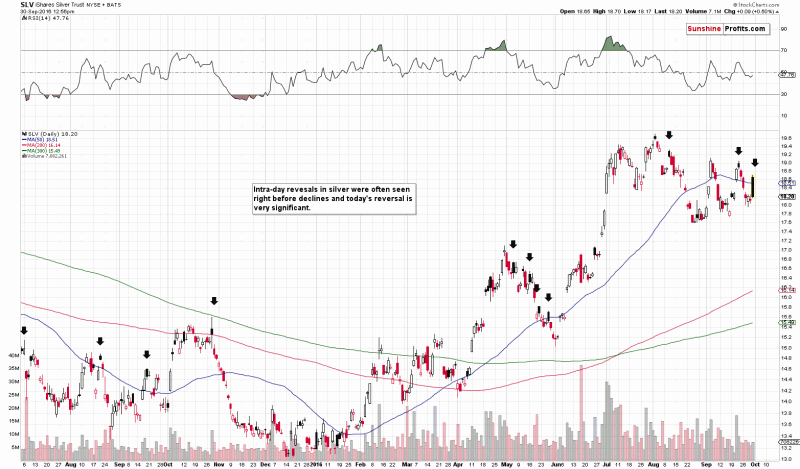
Not only did silver rally much more than gold did (on an intra-day basis), but it also reversed in a profound manner. We have been waiting for the bearish confirmation in the form of silver’s outperformance, and the above temporary rally appears to be “it”.
Looking at the above chart alone has meaningful bearish implications as similar intra-day reversals were quite often seen right before declines. We marked the similar days with black arrows. Almost all declines were confirmed in this way before they begun. What does it mean? That the top is quite likely already in.
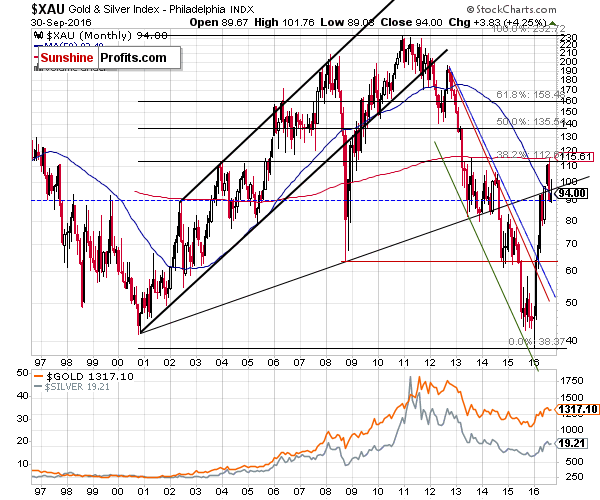
Mining stocks (XAU Index) moved higher last month, but only slightly. The most important thing is that they closed the month below the rising support / resistance line. The implications are bearish as it implies that the temporary move back above the line was a fake one.
Summing up, we had been previously waiting for bearish confirmations and we saw them before Tuesday’s slide. Consequently, based on the above-mentioned factors and as confirmed by today’s move below $1,300 in gold, the bearish medium-term outlook for the precious metals sector became even more bearish (despite positive fundamentals).
If you would like to receive our free newsletter via email, simply enter your email address below & click subscribe.
CONNECT WITH US
Tweets
Tweet with hash tag #miningfeeds or @miningfeeds and your tweets will be displayed across this site.
MOST ACTIVE MINING STOCKS
Daily Gainers
 Lincoln Minerals Limited Lincoln Minerals Limited |
LML.AX | +125.00% |
      |
GCR.AX | +33.33% |
      |
CASA.V | +30.00% |
      |
AHN.AX | +22.22% |
      |
ADD.AX | +22.22% |
      |
AZM.V | +21.98% |
      |
NSE.V | +21.05% |
      |
DYG.V | +18.42% |
      |
AAZ.V | +18.18% |
      |
GLA.AX | +17.65% |

 Follow us on Twitter
Follow us on Twitter Become our facebook fan
Become our facebook fan








